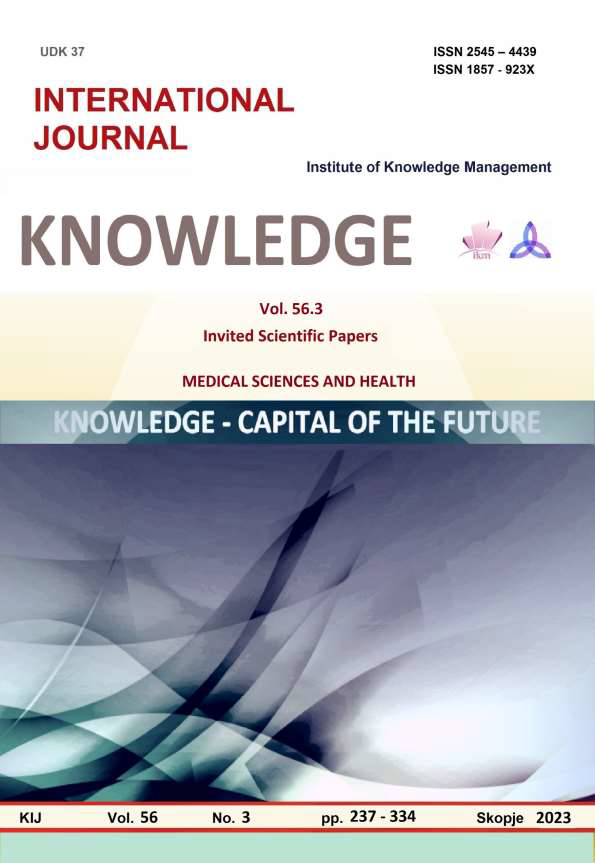THE ROLE OF IONIZED WATER AND ITS IMPACT ON THE ACTIVITY OF GLUTATHIONE PEROXIDASE ON RATS BLOOD SERUM DURING HYPERTHERMIC STRESS
Keywords:
glutathione peroxidase, ionized water, hyperthermic stress, glutathione, vitamin CAbstract
Experimental animals respond to hyperthermic stress (HS) both systemically and cellularly.
Overproduction of ROS brought on by HS decreases the activity of antioxidant defense mechanisms, increasing
oxidative damage. Ionized water (IO) or electrolyzed reduced water (ERW) has already been the subject of various
studies concerning its antioxidant properties. ERW has a very negative oxidation-reduction potential. By scavenging
ROS, ERW with a high pH and a sizable negative redox potential (RP) imitates the actions of other antioxidant
enzymes like superoxide dismutase (SOD) and catalase (CAT). Glutathione peroxidase (GPx) activity is a major
antioxidant defense system that is essential and vital to the overall defensive mechanisms and tactics in biological
systems. Our work used non-enzymatic antioxidants, glutathione, and vitamin C to examine the effects of ERW on
glutathione peroxidase (GPx) activity in blood serum following hyperthermic stress. As an experimental model,
white laboratory rats of the female Wistar breed, with a body weight of 180 to 220 grams, were used, divided into
three groups (15 animals each, n = 45) for applying the appropriate treatment. The animals were housed at a
temperature of 20°C ± 2 ˚C throughout the trial, with a light regime of 12:12 hours. Every animal used in the study
received unlimited access to normal laboratory food and water. Three different groups of treated rats were created.
The first or control group consisted of rats (CPM) drinking commercial mineral water, the second group of rats
(TAM) drank electrochemically reduced water with pH = 9.4 (measured immediately after water activation), while
the third group of rats (TAD) drank electrochemically reduced water (pH = 9.4) with additional glutathione and
Vitamin C. The investigation was conducted for 21 days. The animals in the respective groups were subjected to a
hyperthermic environment for five hours following their respective treatments on the twenty-first day, and this
exposure continued until the animals reached secondary hyperthermia (a body temperature of 43 °C). Acute
hyperthermic exposure caused a significant increase (p < 0.001) in GPx activity in the third group. In the period 7-
14 days, when the rats were not exposed to high ambient temperature, CPM 7 and CPM 14 show a statistically
significant difference in GPx activity (p < 0.001); also TAM 7 and TAM 14 show a statistically significant
difference in GPx activity (p < 0.01). Acute hyperthermic exposure caused a significant increase (p < 0.001) in GPx
activity in the TAD group on day 21. Regarding enzymes belonging to the glutathione redox cycle, IO treatment
with the addition of glutathione and vitamin C during hyperthermic stress led to higher GPx activity in blood serum
References
Behnisch-Cornwell, S., Wolff, L., & Bednarski, P. J. (2020). The Effect of Glutathione Peroxidase-1 Knockout on Anticancer Drug Sensitivities and Reactive Oxygen Species in Haploid HAP-1 Cells. Antioxidants, 9, 1300; doi:10.3390/antiox9121300.
Do, T. D., Mai, N. T., Khoa, T. N .D., Abol-Munafi, A. B., Liew, H. J., Kim, Ch-B., & Wong, L.L. (2019). Molecular Characterization and Gene Expression of Glutathione Peroxidase 1 in Tor tambroides Exposed to Temperature Stress. Evolutionary Bioinformatics Volume 15: 1–8.
Habeeb, A. A. (2018). Oxidative Stress in Animals Exposed to Different Stressful Conditions. Int J Nutr Sci Vol.3 (2)
Ibtisham, F., Zhao, Y., Nawab, A., Liguang, H., Wu, J., Xiao, M., Zhao, Z., & An, L. (2018). The Effect of High Temperature on Viability, Proliferation, Apoptosis and Anti-oxidant Status of Chicken Embryonic Fibroblast Cells. Brazilian Journal of Poultry Science Vol. .20 (3) 463-470
Ighodaro, O.M., & Akinloye, O.A. (2019). First Line Defence Antioxidants-Superoxide Dismutase (SOD), Catalase (CAT) and Glutathione Peroxidase (GPX): Their Fundamental Role in the Entire Antioxidant Defence Grid. Alex. J. Med. 54, 287–293
Li, L., Tan, H., Yang, H., Li, F., He, X., Gu, Z., Zhao, M., & Su, L. (2017). Reactive oxygen species mediate heat stress-induced apoptosis via ERK dephosphorylation and Bcl-2 ubiquitination in human umbilical vein endothelial cells. Oncotarget 8(8): 12902–12916.
Mulgund, A., Doshi, S., & Agarwal, A. (2015). The Role of Oxidative Stress in Endometriosis. Handbook of Fertility; Nutrition, Diet, Lifestyle and Reproductive Health, p. 273-281
Palathingal, P., Mahendra, J., Annamalai, P. T., Varma, S. S., Mahendra, L., Thomas, L., Baby, D., Jose, A., Srinivasan, S., & Ambily, R. (2022). A Cross-Sectional Study of Serum Glutathione Peroxidase: An Antioxidative Marker in Chronic Periodontitis and Chronic Kidney Disease. Cureus 14(2): e22016. DOI 10.7759/cureus.22016
Ridwan R. D., Wuliastuti,W. S., & Setijanto, R. D. (2017). Effect of electrolyzed reduced water on Wistar rats with chronic periodontitis on malondialdehyde levels. Dent. J. Majalah Kedokteran Gigi; 50(1): 10–13
Riyazuddin, R., Bela, K., Poór, P., Szepesi, A., Horváth, E., Rigó, G., Szabados, L., Fehér, A., & Csiszár, J. (2022). Crosstalk between the Arabidopsis Glutathione Peroxidase-like 5 Isoenzyme (AtGPXL5) and Ethylene. Int. J. Mol. Sci. 2022, 23, 5749. https://doi.org/10.3390/ijms23105749
Sarıkaya, E., & Doğan, S. (2022). Glutathione Peroxidase in Health and Diseases DOI: http://dx.doi.org/10.5772/intechopen.91009
Shao, X., Yan, C., Sun, D., Fu, C., Tian, C., Duan, L., & Zhu, G. (2020). Association Between Glutathione Peroxidase-1 (GPx-1) Polymorphisms and Schizophrenia in the Chinese Han Population. Neuropsychiatric Disease and Treatment:16 2297–2305
Shirahata, S., Hamasaki, T., & Teruya, K. (2012). Advanced research on the health benefit of reduced water. Trends in Food Science & Technology, 23(2), 124–131.
Shirahata, S., Hamasaki, T., & Teruya, K. (2018). Newest Research on the Health Benefit of Electrochemically Reduced Water. Department of Bioscience and Biotechnology, Faculty of Agriculture, Kyushu.
Tabuchi, Y., Ahmed, K., & Kondo, T. (2016). Induction of Oxidative Stress by Hyperthermia and Enhancement of Hyperthermia-Induced Apoptosis by Oxidative Stress Modification. Hyperthermic Oncology from Bench to Bedside pp.7-18. DOI:10.1007/978-981-10-0719-4_2
Ugar, M., Tufan, A. N., Altun, M., Guclu, K., & Ozyurek, M. (2018). Current Analytical Chemistry. Glutathione Peroxidase Activity of Biological Samples Using A Novel Microplate-Based Method. Volume 14, Issue 5, Page: 512 - 518, DOI: 10.2174/1573411014666171204154653





